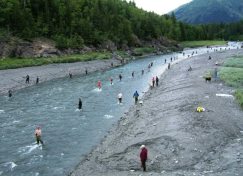
This post was written by Sarah McAfee, a former member of our team.
My parents met in the romantic setting of a fish packing camp in the tiny town of Togiak, Alaska, where they toiled through 20-hour days during the summer wearing rubber overalls and smelling like fish guts. I did not inherit their love of fishing, but was still dragged along on countless fishing trips to “build character” and “gain life skills.” What I mostly did on these excursions—when I wasn’t keeping an eye out for bears—was admire the massive salmon, trout, and other fish fighting valiantly to make their way upstream against the current.
Having spent plenty of time in hip waders standing in some of Alaska’s largest rivers with the other combat fishermen, I know just how strong those currents are, and how much energy you can expend just trying to stay upright, let alone move through the water. Yet year after year these fish return to battle their way home and lay their eggs. Spawning in an easier to access location would be detrimental to future generations because the water isn’t as clean and oxygenated, food sources are more scarce, and predators are more common: it’s the original upstream solution.
In our work we talk a lot about upstream and downstream solutions. Downstream solutions are reactive and often focus on individual-level interventions, while upstream solutions are proactive and often focus on solving the underlying problem. We see examples of these all the time: helping individuals control their diabetes is an important downstream solution, while ensuring communities have access to healthy food and exercise opportunities so they don’t get diabetes in the first place is an important upstream solution. Our board president, Dr. Gary VanderArk has also shared a similar and important lesson about helmets and head injuries. Both downstream and upstream solutions are important, but it is the upstream ones that will improve the health care system overall and make important progress toward a healthier Colorado.
This brings me to our latest project: Action for Equity. It’s clear that there are significant health disparities in Colorado, from the lower rates of Hispanics and Latinos receiving important preventive care to the higher rates of high blood pressure and heart disease in southeast Colorado. Our health is affected by our income, race and ethnicity, education, age, and where we live, learn, work, and play. Addressing these inequities will take more than a focus on nutrition education, lowering alcohol and tobacco consumption, and increasing physical activity. These and many other important downstream solutions are already in place, but we need to take bigger, bolder action if we are to solve the underlying problems of poverty, racism, and other social inequalities that put people at a disadvantage from birth.
Our new series begins to explore the upstream solutions that we as a state could pursue to tackle health equity head on. That means increasing data collection to understand the experiences and needs of those facing disparities, engaging those affected in designing solutions, advancing economic opportunity, supporting community innovations, and much more. We hope you’ll take some time to read through them and share your thoughts and ideas with us about the steps Colorado must take to achieve health equity. We also hope you’ll join is in supporting these and other opportunities for action.
Upstream solutions—as spawning fish know—often require the most time and effort. However, they ultimately improve life for the next generation and beyond, which is a responsibility and opportunity we all share. So, as I did years ago on the banks of the Kenai River, I’m rooting for those willing to do the extraordinary work of going upstream.




